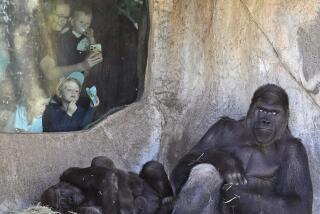Night Life
- Share via
SINGAPORE — After living in Africa for seven years, I cringe at the idea of zoos. Caging the rest of the world’s animal species for what is largely the entertainment of the human species seems perverse, especially after watching them lounge or lope freely on the vast expanses of the Serengeti, Tsavo and Ngorongoro Crater.
So on a stopover here, as part of Secretary of State Madeleine Albright’s entourage on her recent Asian tour, I had mixed feelings about a colleague’s suggestion that some of us squeeze in time to see the world’s only nocturnal zoo one recent evening. But it turned out to be the highlight of the entire trip.
It’s actually called Singapore’s Night Safari, an apt description since it’s more like a wildlife park than a zoo. Eight diverse natural habitats, from the tropical jungles of southeast Asia to the South American pampas and Africa’s equatorial bush, have been crafted from 88 acres of lush rain forest in northern Singapore. About 110 species prance, prowl or play just as they would on home turf.
And romp they do. During our visit in July, our group of five saw a spirited teenage Malay tiger playfully paw and taunt four adult tigers as the pack moved rhythmically together among rocks and shrub. In an area shared with ambling porcupines, a spotted fishing cat from Borneo dipped a paw into a stream then dove in after locating a fish.
A hippo cavorted in the mud. The subtly lighted nighttime setting turns out to be the best way to see wildlife in action. I wrongly thought we’d be seeing only bats, owls and the like. But 90% of all tropical animals are in fact nocturnal--the main reason daytime zoos often yield little beyond sightings of animals that are lethargic, inactive or asleep.
The Night Safari’s twilight world seems almost magical because of the lights, angled around rocks and on poles of heights determined by the species and their routines. The lighting for each landscaped setting was designed by British theater expert Simon Corder, who also did the lighting for the London version of “The Phantom of the Opera” and an array of ballets. Backlit animal movements are accentuated against Singapore’s warm nights year-round, yet there’s no glare or brightness to disturb routines. It’s as if a bright full moon hovers permanently over the park.
In the Indian subcontinent habitat, a shaggy black sloth bear was clearly visible as it swung lazily from a tree, while in the Asian Forest habitat a family of elephants bathed with their trunks. A troop of Cape giraffes grazed in the tropical Africa habitat. Nearby, the rich coloring of the proud zebra-like bongos, large chestnut antelopes with rich white stripes, reflected off the light as they peered curiously back at us. And a velvety-coated gaur, the world’s largest wild cattle, with a shoulder height of up to 6 feet and a weight of more than a ton, strolled slowly in a habitat modeled on the Burmese hills.
*
Despite its size, the park has a special intimacy. Many animals are divided from viewers only by lush vegetation, cascading water and deep moats wider than jumping distances of the more dangerous animals. There are no traditional cages. Some animals are not even confined.
An open-sided tram is one way of traveling the east and west loops of the park. The 45-minute ride with an accompanying English-speaking tour guide is often slowed by herds of sambar and hog deer, tapirs or timid thamins who meander freely--sometimes in front of or alongside the tram on their nightly outings. But even those restricted to island habitats seem close. I felt as if I was looking the endangered one-horned rhino in the eye, while a group of barking sea otters frolicked in the water close to the tramway. Many are so close it’s hard to believe they’re real.
After the tram ride, we meandered, each at his or her own pace, along the three walkways--the Fishing Cat Trail, the Leopard Trail and the Forest Giants Trail--that pass through the same areas as the tram, but often offer even closer views of the animals and from different angles. The Leopard Trail also shows more of the cats and the smaller primates such as the cuddly, big-eyed loris from Vietnam and small, furry tarsier from Indonesia.
The Night Safari, which opened in 1994 at a cost of $43 million, is a major commitment of land for this tiny city-state. Singapore is an island of 3 million people on land only 25 miles long by 15 miles wide--roughly 100 square miles smaller than Los Angeles city limits.
Yet the wildlife park is slightly larger than the 80-acre Los Angeles Zoo and more than half the size of Washington’s National Zoo, which crams 5,000 animals onto 163 acres. The Night Safari has a population of 1,200 animals, about the same number as in the Los Angeles Zoo but only a quarter of the species, so there are more of each animal in the Singapore exhibits. (Other city zoos, such as those in San Diego and Sydney, Australia, stay open at night during the summer season, but remain primarily daytime zoos. Night Safari is closed during the day.)
“We’re creating an illusion that you’re going into a series of national parks at night, so we have to have large spaces in each habitat and larger groups of animals. Both are much better for the animals as well as the viewers,” zoo director Bernard Harrison later told me. With more animals, there’s more interaction within each species. Life seems a bit more normal and less isolated than when one or two animals are confined to a smaller space, as they often are in other zoos.
(Singapore also has a regular zoo nearby, also with many natural landscaped enclosures for its 2,000 animals. The overlap with the nocturnal zoo is only 5%, primarily “arrhythmic” animals such as the giraffe, which can be both nocturnal or diurnal, depending on conditions. We didn’t see the day zoo, but it too has unique touches, such as a miniature railway. Visitors can also share breakfast or high tea with a big, orange-haired orangutan; the day zoo has the world’s largest collection of orangutans.)
*
What makes the Night Safari possible, however, is the climate in Singapore, located just 85 miles north of the equator. “Singapore lies bang on the equator, so we have consistency in nightfall throughout the year. In temperate climates, when it’s dark at night, it’s too cold for both animal and man to be outside. And in summertime, when it’s pleasant, it doesn’t get dark so the animals are not active,” Harrison added. “So Singapore is ideal for a year-round operation like the Night Safari.”
Animals also behave differently in their natural environments than they do in a zoo, Harrison said. And the safari ensures real-life animal performances with an assortment of tricks and treats, such as meat hung in trees or fish released in ponds shortly before the park opens at 7:30 p.m. A giant gnawed bone hanging from a tree was all that remained from dinner in the spotted leopard’s bay.
Almost half the Night Safari’s animals are endangered; some are even rare. Due to hunting and habitat destruction, only about 200 Gir lions are left in their protected native forest in India. The greater one-horned rhino is found in only two national parks in Nepal and India. Families of both can be seen on the Singapore safari. The park also has its own breeding program, with 23 of 43 endangered species producing offspring over the past three years. For botanists, the safari also offers exotic and rare flora, such as the aquilaria, which is prized in China for medicinal uses, and the jelutong, or chewing gum tree, one of the world’s tallest. Some of the thick vegetation towers almost 100 feet high.
The park is as pristine as the rest of Singapore. Despite the often humid climate, we had no problems with mosquitoes or other bugs. The one tacky part is the Burger King, one of two fast-food restaurants at the entrance; the other is an Asian noodle joint. The East Lodge, halfway along the walking trail, also offers sandwiches and juices--and a break to listen to such night noises as barking deer (they really sound like dogs), giggling hyenas and roaring cats. We spent almost 2 1/2 hours on safari but could have used at least another hour. The facility closes at midnight. Despite the fatigue always accrued during Albright’s diplomatic tours, we were the last ones to leave the park.
(BEGIN TEXT OF INFOBOX / INFOGRAPHIC)
GUIDEBOOK
Singapore Fling
Getting there: The Night Safari is a half-hour cab ride from Singapore’s center, but cabs can be expensive. Public transportation is good, cheap and reliable. Take the Mass Rapid Transit (MRT) from the city to Ang Mo Kio (N9) station or Choa Chu Kang (N21) Station and transfer to bus services 138 or 927, respectively, to Night Safari. An alternative is the Trans Island bus 171 from the city to Maindai road, then cross the street and transfer to bus 927.
Night Safari: The wildlife park is open from 7:30 p.m. to midnight. The last tram departs for the 45-minute tour at 11:15 p.m. Admission to the zoo is about $20 for adults, about $14 for children, ages 3-12. (Children under 3 are free). For the tram, one-way fare is about $4 for adults and about $3 for children 3-12.
Where to eat: Night Safari has a Burger King and an Asian food outlet at the entrance. Half way around the park, the East Lodge has sandwiches.
For more information: Singapore Tourist Promotion Board, 8484 Wilshire Blvd., Suite 510, Beverly Hills, CA 90211; tel. (213) 852-1901, fax (213) 852-0129
More to Read
Sign up for The Wild
We’ll help you find the best places to hike, bike and run, as well as the perfect silent spots for meditation and yoga.
You may occasionally receive promotional content from the Los Angeles Times.






